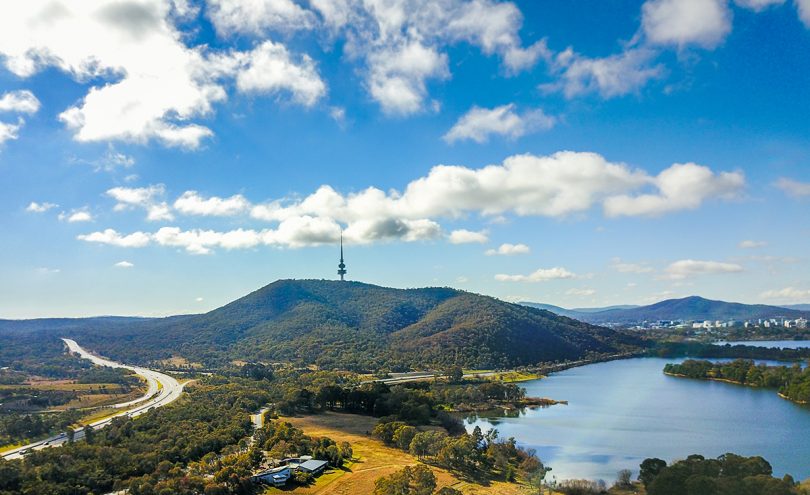
The latest Life in Australia report has named Canberra as the most liveable city in Australia. Photo by Jack Mohr.
Melbourne may have previously won the title of the world’s most liveable city but when it comes to the things which count most to Australians, Canberra is streets ahead.
The latest Life in Australia report by realestate.com.au and Ipsos has named Canberra as the most liveable city in the country for the third year in a row – with Canberrans feeling safer living here and happier about their access to work and education than the residents of every other Australian capital city.
The ringing endorsement from the locals themselves adds to Canberra’s success in being named by Lonely Planet as the third best city to travel to in the world in 2018 and puts us well ahead of Australia’s biggest cities, Melbourne (which came in sixth) and Sydney (seventh). Perth came in second while Adelaide came in third.
However, while the report shows that Canberrans feel the most positive about their city overall, we have the second lowest ranking after Sydney when it comes to ‘affordable decent housing’ and our satisfaction with the quality of our health services has declined over the last couple of years.

Canberra is number one in Australia’s most liveable city ranking. Image by realestate.com.au *Please note that this should be ‘median dwelling price’.
The annual report surveyed 9,515 Australians from October 1-31 last year and asked them to score their own city on 16 criteria ranging from feeling safe to public transport and social cohesion. It also asked them to score which factors they valued most in making an area a good place to live.
‘Feeling safe’ came out as the most important factor in making a city liveable with 67 per cent of respondents selecting this criterion. This was followed by having high-quality health care services nearby (60 per cent), affordable decent housing (58 per cent) and good local job prospects (41 per cent).
Canberra was the only capital city in Australia that valued high-quality educational opportunities in its top five most important liveability factors.
The city’s top five liveability factors were feeling safe (64 per cent), affordable decent housing (57 per cent), high-quality health services (57 per cent), good job prospects (41 per cent), and high-quality education opportunities (38 per cent).

Canberrans ranked the factors they valued most in making an area a good place to live. Education opportunities also came in at 38% but is not shown here. Interactive image sourced from realestate.com.au
Canberrans feel safer but worry about affordable housing
When it comes to rating these five factors out of 10, Canberrans gave feeling safe a score of 7.2, which was the highest of all capital cities but had declined from 7.6 in 2015.
Respondents from Canberra gave the city a low rating of 4.4 for affordable decent housing (declining from 5.2 last year and the second lowest in Australia) and a rating of 6.3 for high-quality health services (declining from 6.9 last year and the fourth lowest of the cities).
Canberrans gave a rating of 5.9 for good job prospects (declining from 6.1 last year) and 6.9 for high-quality education opportunities (declining from 7.0 last year). Canberra’s highest rating out of the 16 criteria was 7.3 out of 10 for ‘access to the natural environment’.
According to the report, Australians feel less safe now about where they live than they did four years ago but this may be more to do with perceptions than reality.
“I think it’s that thing of people thinking there’s more crime going on because of reporting (on crime) versus the statistics that show there is less crime,” said realestate.com.au’s chief economist, Nerida Conisbee.
“I think it’s the way information is disseminated that’s probably making a difference. The more you hear about it, the more you worry about it.”
Safety is number one for renters and home owners
Ms Conisbee said that safety is the number one consideration for renters and home owners.
“These would be factors that would make or break, in terms of looking at a suburb. If it didn’t feel safe, you’d be very unlikely to consider that suburb,” she said.
Ms Conisbee said that data shows the housing boom has led to a notable decrease in local affordable housing with it being a big issue in Australia compared to other countries. The report said that Canberra’s median dwelling price is $595,000, which is the third highest behind Sydney and Melbourne.
Ms Conisbee said that access to health services ranks highly, particularly in rural or regional areas.
“If you move to regional parts of Australia it becomes a far bigger deal if you don’t have a local hospital, let alone a local doctor service.”
How would you rank Canberra in terms of liveability? Let us know in the comments below.













